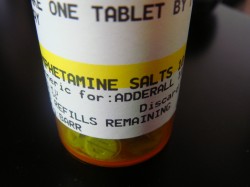
Adderall, one of a handful of prescription medications used to treat attention-deficit hyperactivity disorder, has also become a fairly popular drug of abuse. As a prescription amphetamine drug, Adderall is considered a controlled substance, categorized as a Schedule II narcotic.
As with any controlled substance, Schedule I and Schedule II classes in particular carry a high risk for abuse and addiction. Anyone who takes this drug on a long-term basis or disregards prescription guidelines will start to show Adderall addiction signs over time.
Like most every amphetamine-type drug, Adderall increases a person’s energy levels, concentration and overall mood by speeding up central nervous system processes. Adderall addiction signs develop as the drug starts to overpower normal brain chemical processes.
Over time, gradual changes in a person’s physical and psychological health start to surface as the effects of the drug continue to weaken brain and body processes. Here are five of the most common Adderall addiction signs to watch out for:
1. Increased Dosages
Adderall works as a central nervous system stimulant that speeds up most every major bodily process. By stimulating individual cell receptor sites in the brain, Adderall causes excess amounts of vital neurotransmitter chemicals to be released in the brain.

Filling prescriptions early is a sign of Adderall abuse.
According to the University of California Irvine School of Medicine, this overstimulation of receptor sites causes brain cells to grow weaker with each successive dose. In the process, they become desensitized to Adderall’s effects. When this happens, larger doses are needed to produce the same desired effects. This Adderall addiction sign will persist for as long as a person keeps using.
2. Withdrawal Symptoms
While many people tend to associate withdrawal symptoms with detox, long-term Adderall users will experience withdrawal symptoms on a regular basis. Ongoing Adderall use causes widespread chemical imbalances to develop in the brain.
As brain chemical imbalances worsen, the brain becomes unable to properly regulate bodily processes. Withdrawal symptoms develop as different bodily processes start to breakdown.
Withdrawal symptoms commonly take the form of:
- Insomnia
- Loss of energy
- Headaches
- Irritability
- Angry outbursts
- Constipation
Withdrawal-type Adderall addiction signs mark the first stage in the addiction process.
3. Aggressive/Psychotic Behaviors
Healthy psychological functioning relies on the brain’s ability to maintain a delicate balance of neurotransmitter chemicals. According to the U. S. Food & Drug Administration, once imbalances start to form, Adderall’s effects leave users unable to control their impulses, emotions and reasoning abilities. In turn, a person starts to exhibit the following Adderall addiction signs:
- Aggressive behaviors
- Violent outbursts
- Paranoid
- Delusions of grandeur
- Risk-taking behaviors
4. Exhaustion
Long-term Adderall use essentially “burns out” brain cell receptor functions, an effect that mirrors how other bodily processes are affected. Over time, Adderall addiction signs of exhaustion and fatigue result from the body’s inability to properly metabolize food nutrients. As a result, a person’s energy levels remain abnormally low.
5. Lifestyle Signs
As the brain and body become more dependent on Adderall’s effects, a person’s motivations and priorities start to center on getting and using more drugs. Adderall addiction signs affecting a person’s lifestyle most often take the form of:
- Missed days at work
- Relationship problems
- Failing health
- Decline in appearance and grooming
- Legal problems
- Financial problems


